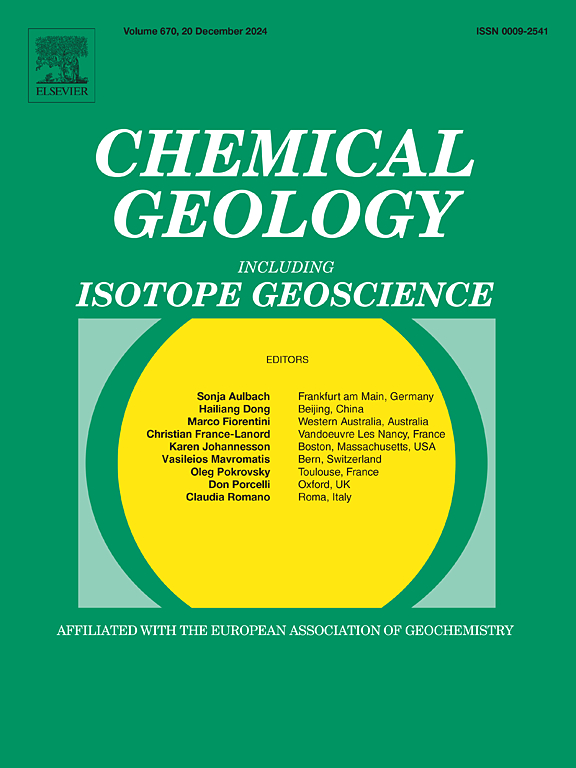91500、GJ-1/89和TEMORA-2锆石标准物质的非均质性
IF 3.6
2区 地球科学
Q1 GEOCHEMISTRY & GEOPHYSICS
引用次数: 0
摘要
锆石是使用激光烧蚀ICP-MS分析最多的矿物,部分原因是其微量元素系统可以用于探索广泛的岩石成因过程。然而,内部化学分带是锆石的一个共同特征,它可以导致化学上不同的晶体域取样。这不仅会影响未知的锆石,还会影响用于评估数据准确性和精密度的锆石二级参考物质。为了更好地解决锆石地球化学非均质性的程度,我们对3种广泛分布的锆石基准物质91500、GJ-1/89和TEMORA-2进行了长期激光烧蚀Q-ICP-MS微量元素数据(n = 6342)。锆石91500和GJ-1/89在高光谱阴极发光(CL)中具有体积小的异常结构域,表现出与这些参考物质中记录的小条带无关的大尺度化学特征。91500年的成分变异性程度明显更大,特别是REE + Y(91500带间偏差= 51 - 63%;GJ1/89 & lt;5%,除了Ce)。铀和钍表现出非常相似的数据趋势,变化幅度为2-3倍。相反,TEMORA-2具有强烈的扇形区,呈现出垂直于c轴生长的棱镜扇形和沿c轴生长的金字塔扇形所定义的双峰分布。棱柱在金字塔上富集了330% ~ 85% (Pr-Lu)的REE + Y。铀、钍和铅的棱柱区富集度分别为71%、160%和75%。Cerium,以及HFSE和P似乎是独立于行业的。在TEMORA-2锆石中观察到的化学非均质性强调了对扇形锆石进行结构约束分析的普遍需求。我们的数据表明,GJ-1晶体是最好的锆石微量元素参考物质,而91500是一个很好的选择,只要能追踪到较小的异常域。本文章由计算机程序翻译,如有差异,请以英文原文为准。
Compositional heterogeneity in 91500, GJ-1/89 and TEMORA-2 zircon reference materials
Zircon is the most analysed mineral using laser ablation ICP-MS, partly because its trace element systematics can be used to explore a broad range of petrogenetic processes. However, internal chemical zoning, a common feature in zircon, can result in sampling of chemically distinct crystal domains. This affects not only unknown zircons, but also zircon secondary reference materials used to assess data accuracy and precision. To better resolve the extent of geochemical heterogeneity in zircon, we present long-term laser ablation Q-ICP-MS trace element data (n = 6342) for three widely distributed zircon reference materials: 91500, GJ-1/89 and TEMORA-2. Zircons 91500 and GJ-1/89 have volumetrically minor domains that appear anomalous in hyperspectral cathodoluminescence (CL) and represent large scale chemical features unrelated to minor banding documented in these reference materials. The extent of compositional variability is significantly greater in 91500, particularly for the REE + Y (91500 bias between zones = 51–63 %; GJ1/89 < 5 %, except Ce). Uranium and Th show very similar data trends with 2-3× variation. In contrast, TEMORA-2 is strongly sector-zoned, showing bimodal distributions defined by prism sectors growing perpendicular to the c-axis and pyramid sectors growing along the c-axis. Prisms are enriched in REE + Y from 330 % to 85 % (Pr–Lu) over pyramids. Uranium, Th and Pb show prism sector enrichments of 71 %, 160 % and 75 %, respectively. Cerium, together with the HFSE and P appear to be sector independent. The chemical heterogeneity observed in TEMORA-2 zircon highlights the universal need to obtain texturally constrained analyses in sector-zoned zircons. Our data indicate that the GJ-1 crystals represent the best available zircon trace element reference material, and that 91500 is a good alternative provided minor anomalous domains are tracked.
求助全文
通过发布文献求助,成功后即可免费获取论文全文。
去求助
来源期刊

Chemical Geology
地学-地球化学与地球物理
CiteScore
7.20
自引率
10.30%
发文量
374
审稿时长
3.6 months
期刊介绍:
Chemical Geology is an international journal that publishes original research papers on isotopic and elemental geochemistry, geochronology and cosmochemistry.
The Journal focuses on chemical processes in igneous, metamorphic, and sedimentary petrology, low- and high-temperature aqueous solutions, biogeochemistry, the environment and cosmochemistry.
Papers that are field, experimentally, or computationally based are appropriate if they are of broad international interest. The Journal generally does not publish papers that are primarily of regional or local interest, or which are primarily focused on remediation and applied geochemistry.
The Journal also welcomes innovative papers dealing with significant analytical advances that are of wide interest in the community and extend significantly beyond the scope of what would be included in the methods section of a standard research paper.
 求助内容:
求助内容: 应助结果提醒方式:
应助结果提醒方式:


